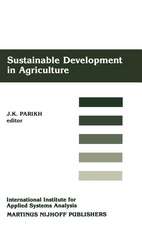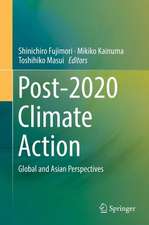Electrokinetics Across Disciplines and Continents: New Strategies for Sustainable Development
Editat de Alexandra B. Ribeiro, Eduardo P. Mateus, Nazaré Coutoen Limba Engleză Hardback – 8 sep 2015
| Toate formatele și edițiile | Preț | Express |
|---|---|---|
| Paperback (1) | 844.61 lei 6-8 săpt. | |
| Springer International Publishing – 23 aug 2016 | 844.61 lei 6-8 săpt. | |
| Hardback (1) | 656.25 lei 6-8 săpt. | |
| Springer International Publishing – 8 sep 2015 | 656.25 lei 6-8 săpt. |
Preț: 656.25 lei
Preț vechi: 772.05 lei
-15% Nou
Puncte Express: 984
Preț estimativ în valută:
125.57€ • 131.46$ • 103.90£
125.57€ • 131.46$ • 103.90£
Carte tipărită la comandă
Livrare economică 05-19 aprilie
Preluare comenzi: 021 569.72.76
Specificații
ISBN-13: 9783319201788
ISBN-10: 3319201786
Pagini: 350
Ilustrații: XV, 469 p.
Dimensiuni: 155 x 235 x 33 mm
Greutate: 0.86 kg
Ediția:1st ed. 2016
Editura: Springer International Publishing
Colecția Springer
Locul publicării:Cham, Switzerland
ISBN-10: 3319201786
Pagini: 350
Ilustrații: XV, 469 p.
Dimensiuni: 155 x 235 x 33 mm
Greutate: 0.86 kg
Ediția:1st ed. 2016
Editura: Springer International Publishing
Colecția Springer
Locul publicării:Cham, Switzerland
Public țintă
Professional/practitionerCuprins
Part I Introduction and Overview of the Process.- 1. Overview of the Eletrokinetic Process.- 2. Electrochemical Remediation Technologies.- Part II Remediation of Contaminants and Recovery of Secondary Resources with Socio-Economical Value.- 3. Electrochemical Process for Phosphorus Recovery from Wastewater Treatment Plants.- 4. Electrochemical Process for Phosphorus Recovery from Incinerated Sewage Sludge.- 5. Electrochemical Process for Phosphorus Recovery from Water Treatment Plants.- 6. Electrokinetic Remediation Applied to Different Porous Matrices: Mine Tailings, Soils, Sediments, Ashes, Treated Wood Waste.- 7. Advanced Analytical Techniques for Matrix Characterization and Contaminants Monitorization.- Part III Conservation of Cultural Heritage and Use in Construction Material.- 8. Restoration of salt-damaged traditional ceramic tiles9. Construction and Road Materials Using Ashes// Upgrading of Bio-Ashes as Admixture In Cement Based Materials.- Part IV Mathematical Modeling of the Electrokinetic Process.- 10. Theoretical aspects of mathematical modeling applied to the electrokinetic process.- 11. Electrokinetic Modelling of Organic Compounds.- Part V Coupling Electrokinetic Process with Other Technologies to Enhance Performance and Sustainability.- 12. Enhanced Technologies Applied with Electrokinetic Remediation.- 13. Nanoremediation Coupled to the Electrochemical Process for PCB Removal from Soils.- 14. Phytoremediation Coupled to the Electrochemical Process for Contaminants Removal.
Notă biografică
Alexandra Branco Ribeiro is an Associate Professor, Departamento de Ciências e Engenharia do Ambiente, Faculdade de Ciências e Tecnologia, at Universidade Nova de Lisboa in Portugal.
Textul de pe ultima copertă
The socio-economic activities due to world development are promoting increasing pressures on land, creating competition and conflicts, resulting in suboptimal use of resources. There is a need to find new strategies for sustainable development that link social and economic progress with environmental protection and enhancement. Electrokinetic transport processes (EK) uses a low-level direct current as a “cleaning agent”. EK has been applied to the remediation of polluted soils and other contaminated matrices. It also shows a great potential to be used in different fields, as in saline soil restoration, nutrients recovery from wastes or repair and maintenance of building structures. EK introduces a new integrated approach aiming at sustainable development and to support waste strategies with worldwide interest. EK can also be coupled with phytoremediation and integrated with nanotechnology, enlarging the scope of its application. The use of EK in the recovery of secondary resources, remediation, and conservation, is a multidisciplinary and novel approach. EK opens up new technical possibilities for waste minimization, through upgrading of particulate waste products, and the recovery of secondary resources for industrial, agricultural or social use.
Caracteristici
Offers an overview of electrokinetic (EK) remediation technologies Describes how EK can be used to remediate contaminants in water, soil, sewage, wood waste and more Shows how EK can be coupled with other technologies to enhance performance and stability




























